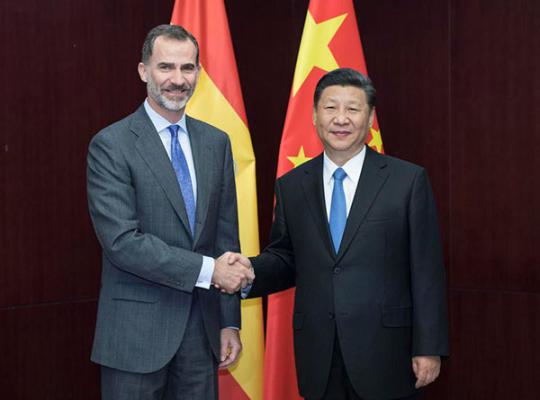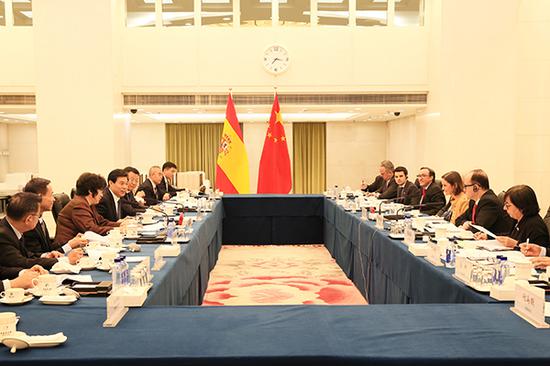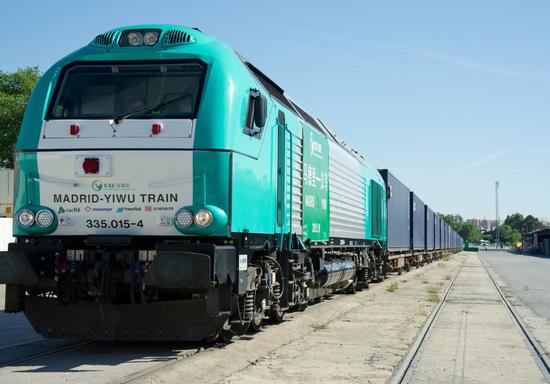China-Spain ties at a glance
President Xi Jinping starts his three-day state visit to Spain on Nov 27 at the invitation of King Felipe VI of Spain.
Xi's visit to Spain, the first state visit to the country by a Chinese president in 13 years, falls on the 45th anniversary of the establishment of diplomatic ties between the two countries.
During his visit, Xi will exchange views with Spanish leaders so as to further develop the China-Spain comprehensive strategic partnership, promote the docking of the development strategies in the framework of China's Belt and Road Initiative, and strengthen bilateral cooperation in various fields, Chinese Ambassador to Spain Lyu Fan told media.
Let's take a look at some highlights of high-level exchanges, pragmatic cooperation and people-to-people exchanges between the two countries.
Political ties

President Xi Jinping meets with Spanish King Felipe VI in Astana, Kazakhstan, on June 9, 2017. (Photo/Xinhua)
Diplomatic relations between China and Spain were established on March 9, 1973.
The comprehensive strategic partnership between the two countries, established in November 2005, has continued to deepen and exchanges and cooperation also have expanded.
The two countries enjoyed close exchanges at the top level and strong political mutual trust in recent years.
On June 9, 2017, when meeting with Spanish King Felipe VI in Astana, Kazakhstan, Xi said that China and Spain should make full use of the China-Europe rail line, connecting Yiwu city in East China with Madrid.
The Spanish king also expressed his willingness for strengthening political trust, deepening high-level exchanges and enhancing practical cooperation in all areas with China.

Economic and trade cooperation
Bilateral trade volume has grown from $12 million at the beginning of establishment of diplomatic ties to over $30.9 billion in 2017.
China is now Spain's largest trading partner outside the EU, while Spain is the sixth-biggest trading partner of China within the EU.

The freight train between China's small commodity hub, Yiwu, and Spain's capital, Madrid, which was put into service in November 2014, has become an important bridge of interconnectivity across the Eurasian landmass, and also an early achievement of the BRI construction.
Investments from Chinese companies have rapidly increased in Spain in recent years, with a stock of more than $2.3 billion, covering sectors including energy, agriculture, finance, logistics, telecommunications and infrastructure.
By the end of Aug 2018, Spain had invested 2,461 projects in China, with an actual investment of $3.79 billion.
There are more than 700 Spanish companies in China, covering industries such as finance, energy, telecommunications, and transportation.
People-to-people exchanges

China and Spain have a fruitful cooperation in various fields, such as science and technology, culture, education and tourism.
China has officially included the Spanish language in its high school curriculum, and Spain also will make efforts to integrate the Chinese language into the Spanish national education system.
At present, there are eight Confucius Institutes and eight Confucius classes in Spain.
By the end of 2017, Chinese students studying in Spain had exceeded 13,000, while Spanish students studying in China had surpassed 4,000.
According to TourSpain, 514,000 Chinese travelers came to Spain in 2017, spending 790 million euros, with the highest per capita consumption among countries. In contrast, China received 156,000 Spanish tourists in 2017, up by 4.28 percent compared with the previous year.
As of June 2018, the two countries had established 26 pairs of friendly provinces and cities.
- Back _articles: China hopes UK and EU will finally reach consensus on Brexit
- Next _articles: Full text of Xi's signed article on Spanish newspaper